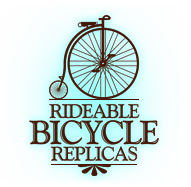Riding a hiwheel bicycle can be an enjoyable pastime, but having a good idea of what to do before you climb on is key to the experience. Below are a few points to keep in mind.
1. Preparing to Mount:
Mount from the rear. Grasp handlebars loosely. Place your left foot on the step while your right foot pushes. Push rapidly but cautiously; cycle should be moving fast before attempting to stand on the step. See the Size Chart to make sure your hiwheel is the right size for you.
2. Scooting & Practicing Steering:
Do not sit on the seat or pedal until you have mastered steering and scooting along. Stand on the rear step and scoot rapidly, then mount and pedal.
3. Dismounting:
Reach back with your left foot, point toe and place the ball of your foot on the step. Remember, keep pedaling with your right foot until left foot finds the step. Dismount to the side. (It's like getting off a horse.)
4. Riding:
The hiwheel should be ridden with forearms stiff until cycle is mastered. Speed must be kept up during turns.
5. Maintainence:
Spokes may loosen occasionally, and wheels may need maintenance right out of the box and or on a regular basis. Use a proper spoke tool carefully, do not over tighten nipples and spokes. Tension should only ever be "snug". These spokes are longer than most cycles in the world and tend to stretch and move more due to the size of the wheel and length of the spoke. This movement of the rim and spokes in the wheel is normal. Spokes are also wearing items and can break. This can be due to any number of reasons including but not limited to, over tightening, dropping, falling, freight damage, a really aggressive rider, an unbalanced true of the wheel, age, and a few other things. One or two broken spokes shouldn't worry you for riding but always replace broken spokes as soon as possible, and do not ride with more than 4 (spread around the wheel) being broken.
Tire gap at the tire joint can happen for a number of reasons. Sometimes excessive temperature variations and or dirt, or water will cause front tire to gap at the seam due to the tire self-vulcanizing to the rim. Sometimes people over tighten a nipple and the spoke jabs into the tire. The maintenance procedure for a gap is usually simple lubrication of the tire and wheel. At the gap in the joint, liberally flood the wire and tire through the hole that the wire passes through. Flood the rim where the tire touches all the way around. From the gap, wiggle the tire roughly up to 18" along from the gap. This is to free up any spot the tire has stuck to the rim. Then ride. The gap usually will close within half a block of riding. Repeat if required. That will usually solve most gapping issues, but it is not effective for a tire that has worn past its life expectancy, is so old that the rubber has lost all elasticity, or has spokes sticking out past the nipple end and catching the tire rubber. Refer to the Tire Install page/video for tips on lubrication of the tire.
6. Disclaimer:
Ride any hiwheel bicycle at your own risk. They're a lot of fun, but they can be dangerous if not treated with the respect they deserve.
For examples of how to transport your bike, see How to Transport a Hiwheel.








